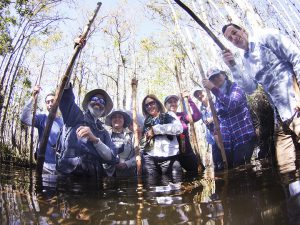
While friends and family in more northern parts of the United States are rejoicing in the sighting (or lack thereof) of Groundhogs Day’s Puxatawney Phil, we here in South Florida are recognizing a different holiday that has special significance: World Wetlands Day. At the western border of Miami-Dade County lies the vast area that we know as the Everglades National Park. The 1.5 million acres Everglades is one of the largest wetlands in the world, and is home to nine distinct but interconnected habitats, as well as thousands of plant and animal species.
In the last 100 years, the Everglades and Lake Okeechobee have been altered dramatically to make way for human settlement. Fresh water from Lake O used to flow south into the Everglades, eventually spilling out into Florida and Biscayne Bays, but now the water has been channeled to flow through canals to the east and west. These changes in hydrology resulted in major changes to the environment. After many years of research and monitoring activities that demonstrated the negative impacts of these modifications, legislation was proposed to begin restoration of this system.
The Comprehensive Everglades Restoration Plan (CERP) was signed into law in the year 2000. In a nutshell, it’s a federal-state partnership designed to improve the timing, delivery, and quality of water that flows through the Kissimmee-Okeechobee-Everglades watershed. In other words, the ultimate end goal of the CERP will be to try and mimic the historical water regime into and through Everglades National Park. This plan is critically important to our future, as one of its goals is to keep drinking water available to the residents who depend upon it. To learn more about the CERP, go here.
If you’re looking for ways to celebrate World Wetlands Day, look no further: take a drive down to the Ernest Coe Visitor Center in Homestead, pop in and check out the exhibits, or if you’re really adventurous, lace up your boots and quick-dry pants and go on a “slough slog” (a walk/wade through water in a bald cypress dome). If you’d rather stay dry, throw your bike in the car and drive west on Tamiami Trail to Shark River Valley and enjoy a scenic 16-mile bike ride around Shark River Slough. Don’t forget your walking stick, water bottle, and helmet.
 0
0

